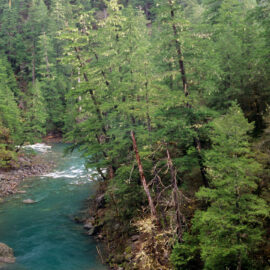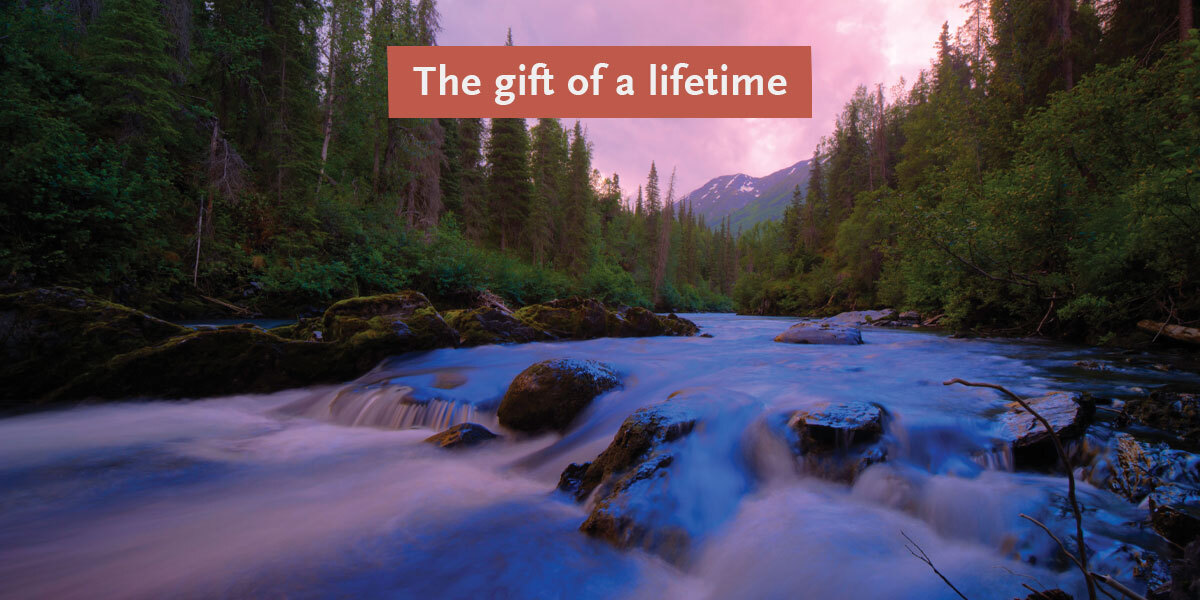Oregon’s logging rules along salmon streams lag far behind all Northwest states. A new agreement could offer a path forward.
Today, Governor Kate Brown announced that representatives of the timber industry and conservation groups have agreed to jointly pursue new forestry reforms in Oregon. The agreement includes new rules on spraying of pesticides, new protections for streams in the Rogue-Siskiyou region of Southwest Oregon, and a new framework for developing comprehensive protections for salmon and other endangered aquatic species throughout the state. Below, a primer on the pact’s highlights and key questions.
Highlights:
- Increased notification for Oregon residents, including real-time alerts, during pesticide spraying on forestlands.
- Pesticide spraying would be prohibited:
- Within 300 feet of schools and homes;
- Within 300 feet of all drinking water sources;
- Within at least 50 feet of all salmon streams and upstream waterways.
- Expanded forested buffers along salmon, steelhead and bull trout streams in the Rogue-Siskiyou region of Southwest Oregon.
- An agreement to work on a forest practices reform package that will form the basis for a federally approved plan to protect salmon and other aquatic species in Oregon. This is known as a Habitat Conservation Plan. The new framework for forest practices rulemaking in Oregon will seek to decrease risk to endangered species and water quality, allow for adaptive management on forestlands, and include special provisions for small landowners.
Why do we need to update forest practices in Oregon?
Oregon was once a leader in protecting forested streams. But for decades, the state has been falling behind. Oregon’s outdated logging rules are now far less protective than in neighboring Washington, Idaho, and California. And that’s harming Oregon waterways and taking a steep toll on fish, wildlife, and communities. Citizen groups recently filed several ballot initiatives designed to improve forest practices in Oregon.
Why did the two sides come to an agreement now?
Both sides stated that they believe they can get better results and certainty on environmental and business outcomes through a new cooperative process. The Memorandum of Understanding states: “The Cooperating Parties stand to gain by pursuing an alternative path informed by science with a mutual willingness to compromise that achieves high quality environmental outcomes and certainty for everyone involved.”
Wild Salmon Center has worked in the past to reform forest practices through the state Board of Forestry, but that process has not achieved the outcomes that salmon need in Oregon. We believe a new path is needed.
Why was the timeline of this agreement so short?
This deal was driven by the timeline of the short legislative session. This is the only time to legislate an alternative to the ballot initiatives slated for the fall elections. Negotiations didn’t start until January 27 and we did not reach a tentative agreement until late Thursday, February 6. Ideally we would have had more time to socialize the terms of the deal with Oregonians before we moved to the legislative phase, but we are at the mercy of the political calendar.
How will the new agreement benefit Oregonians?
Salmon depend on clean, cold water and this agreement creates a path to ensure that logging practices don’t warm streams, reduce spawning and rearing grounds, and load sediment into streams, which can smother salmon eggs. In addition, measures in the agreement will protect communities and their drinking water from the potentially harmful effects of pesticide spraying on timberlands.
Is there any precedent for the comprehensive habitat planning process that is part of this deal?
A collaborative process called Forests & Fish in Washington State led to statewide habitat conservation plan with over 60,000 stream miles and 9.3 million acres of Washington forests being protected.
Will this habitat plan allow timber companies immunity from legal action to protect endangered species?
The Habitat Conservation Plan we hope to negotiate will result in new state laws to protect endangered salmon through requirements like bigger stream buffers where no logging can occur. Timber companies will have protection from legal action but only if they are complying with the Habitat Conservation Plan. If timber companies don’t follow those rules, the state will penalize them.
The HCP will require rigorous monitoring to ensure the protections are working. And citizens will get a chance to comment and sue if they think the HCP rules aren’t good enough. Under the current system, it is extremely hard to bring litigation to protect salmon on private forests. In many cases people can’t get access to even see what is going on.
Does this agreement prevent peaceful protest or demonstrations against aerial spraying?
No, it does not prevent protest or any other free speech on public or private property where a person has a lawful right to be. The legislation does provide for a fine for using violence or force to interfere with a helicopter operator or operation. The interference is a classified as a violation, like a parking ticket.
Will people be fined and prosecuted for hiking on nearby public land or photographing logging operations from the public right of way or private land where they have a right to be?
No, lawful protest, free speech, hiking nearby or documenting the spray all remain protected by the Oregon Constitution.
What happens next?
The Oregon Legislature will need to enact laws related to pesticide spray, Southwest Oregon stream rules, and the development of a comprehensive, statewide habitat protection plan. If those three milestones are met this spring, both the conservation community and the timber industry have agreed to abandon dueling ballot initiatives on forest practices, along with related lawsuits.




